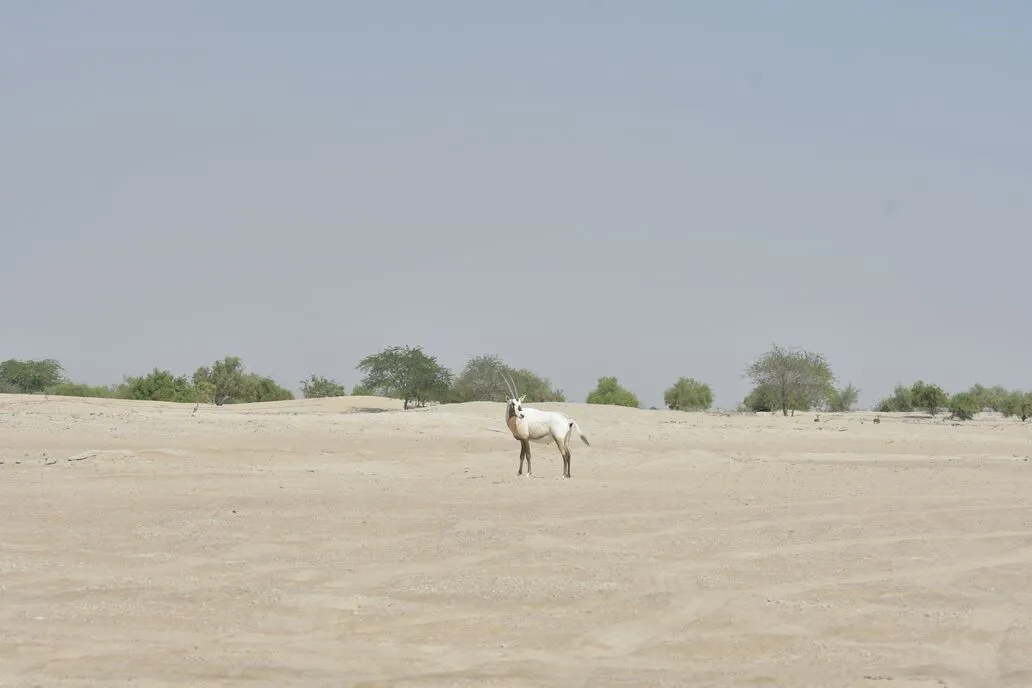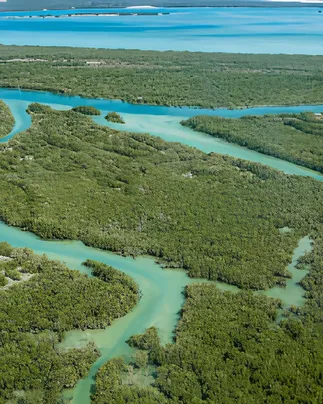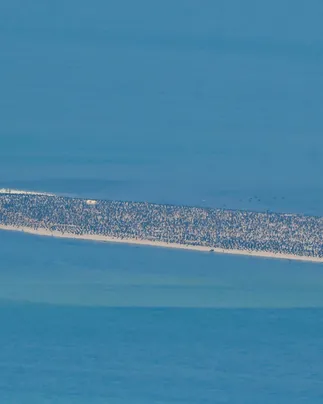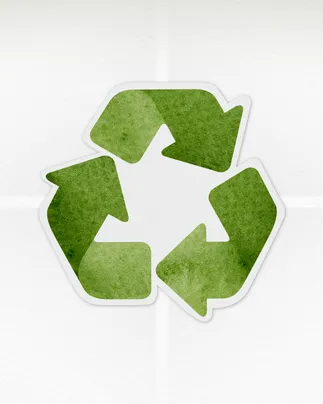Under the directies of His Highness Sheikh Hamdan bin Zayed Al Nahyan, Ruler's Representative in Al Dhafra Region and Chairman of the Board of Directors of the Environment Agency - Abu Dhabi (EAD), the Agency in coordination with Al Dhafra Region Municipality, has recently released a new group of Arabian Oryx into the Houbara Protected Area. The group is the first of 100 Arabian Oryx to be released in stages before the end of the year. Located in Baynunah, the Houbara Protected Area is managed by EAD, and extends over a total area of 774 square kilometers.
An important step towards the resettlement of the Arabian Oryx and the enhancement of their numbers in the wild, the initiative, which is supervised by EAD, is part of the Sheikh Mohamed Bin Zayed Arabian Oryx Reintroduction Programme, and aims to release the Arabian Oryx back into their natural habitat, within large reserves. In the past, the formation of growing herds capable of being self-reliant and roaming freely within their natural habitat, was effective once management programmes and long-term protection plans were put into place.

EAD Releases a New Group of Arabian Oryx in the Houbara Protected Area
Expressing his pride with the successful release, His Highness Sheikh Hamdan bin Zayed Al Nahyan said: “The Emirate is committed to preserving wildlife and endangered species, and the release of these majestic animals into the wild constitutes a moment of pride for us. This emphasizes our efforts to reintroduce the Arabian Oryx, a project that was launched in Al Ain City back in 1968.”
His Highness Sheikh Hamdan bin Zayed Al Nahyan added: “The late Sheikh Zayed bin Sultan Al Nahyan issued his directives to establish programmes to protect the Arabian Oryx, such as breeding and protecting the wild animals from extinction, whilst reintroducing them back into their natural habitat. Following this, His Highness Sheikh Mohammed bin Zayed Al Nahyan launched a similar programme in 2007, which is part of the Abu Dhabi government's vision to create a regional herd that reflects all programmes for the resettlement of the Arabian Oryx in their range countries.
Arabian Oryx Reintroduction Programme... has resulted in changing its status in 2011, in the Red List of the International Union for Conservation of Nature, from “endangered” to “vulnerable to extinction”
Hamdan bin Zayed Al Nahyan
“During the past few years, the UAE, specifically the Sheikh Mohamed Bin Zayed Arabian Oryx Reintroduction Programme, has played a pivotal role in protecting the Arabian Oryx, preserving it from extinction and enhancing its numbers in the wild. This has resulted in changing its status in 2011, in the Red List of the International Union for Conservation of Nature, from “endangered” to “vulnerable to extinction”. This is considered as one of the most important achievements in the field of the reintroduction of species on a global level.”
Her Excellency Dr. Sheikha Salem Al Dhaheri, Secretary-General of EAD said: “Within the framework of the Sheikh Mohamed Bin Zayed Arabian Oryx Reintroduction Programme, the Agency has implemented a programme for the reproduction and release of the Arabian Oryx in the United Arab Emirates. The Arabian Oryx was released in the Arabian Oryx Protected Area and today, more than 800 heads live freely within the reserve's borders. In addition, groups of Arabian Oryx were also released in Qasr Al Sarab Protected Area.”
Her Excellency added: “Today, the programme is considered one of the most successful species preservation programmes in the world, contributing to increasing the number of Arabian Oryx in a range of different countries. Concurrently, it has increased the numbers in the UAE, with the country hosting more than 10,000 Arabian Oryx, 5,000 of which, can be found in the Emirate of Abu Dhabi alone, which is the largest group of Arabian Oryx in the world.”

Abu Dhabi hosts 5,000 Arabian Oryx
EAD is committed to preserving the Arabian Oryx on a regional level, and the implementation of the plan for the reintroduction and release of this species is not only limited to the United Arab Emirates. The programme extends to the Sultanate of Oman and the Hashemite Kingdom of Jordan, where hundreds of Arabian Oryx were released within their natural and historical range countries.
Her Excellency said: “Within the framework of the Memorandum of Understanding, signed between EAD and the Royal Society for the Conservation of Nature, a project to develop a vital herd of Arabian Oryx within the Shumari Wildlife Reserve - Jordan, was initiated. A total of 60 heads of Arabian Oryx will be released into the Shumari Wildlife Reserve, to ensure their adaptation to the region's environment.”
UAE, with the country hosting more than 10,000 Arabian Oryx, 5,000 of which, can be found in the Emirate of Abu Dhabi alone, which is the largest group of Arabian Oryx in the world
Dr. Sheikha Salem Al Dhaheri, Secretary-General of EAD
Her Excellency also stated: “EAD hosts the General Secretariat for the Conservation of the Arabian Oryx, which was established in 2001, under the Coordination Committee for the Conservation of the Arabian Oryx. The secretariat aims to coordinate and unify efforts to conserve the Arabian Oryx in a range of countries in the Arabian Peninsula. This is achieved through the implementation of a regional strategy, which creates sustainable groups of Arabian Oryx, which live freely within their historical range of habitats.
“EAD is keen to provide high genetic diversity within the groups of Arabian Oryx released, and has taken the necessary steps to establish a "global herd" for the Arabian Oryx at the Deleika Wildlife Conservation Centre in Abu Dhabi. This is to ensure the sustainability and continuity of future generations of Arabian Oryx, and to protect their numbers from the negative effects of interbreeding over a long period of time.”

Arabian Oryx in the Houbara Protected Area
The Houbara Protected Area was established in 2008 with the main objective of protecting the natural habitats suitable for breeding Houbara bustard. The reserve embraces many important animal and plant species locally and internationally, and it is managed by EAD as it supervises many projects in this region. This also includes the project to protect migratory Houbara bustard from extinction, as they are considered an endangered species and listed as an animal threatened to extinction on the International Union for Conservation of Nature (IUCN) Red List.
The Houbara Protected Area is located in the Al Dhafra region, with an area of about 774 square kilometers, and it is completely fenced. The main environments in the reserve include sandy surfaces, gravel plains, sabkha and small sand dunes that consist of whitish sand in most areas. Planted forests are also found within the reserve's boundaries, and its importance lies in being one of the first sites to record a nesting of Houbara bustard.









